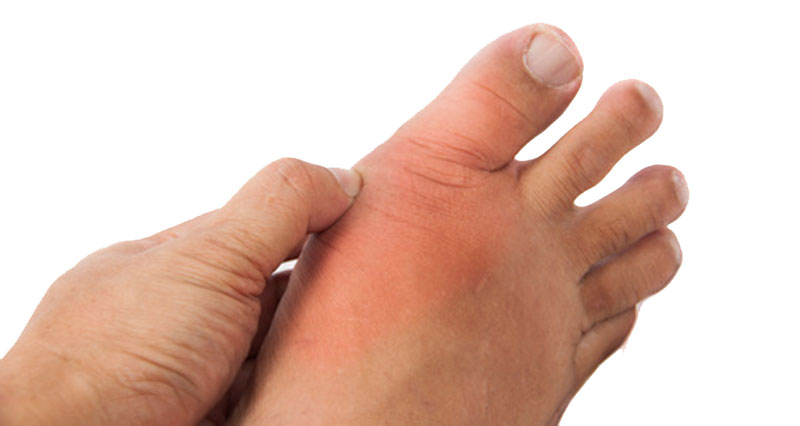
Clues to Gout In The Foot: Painful Indications
Share
Gout is a form of arthritis that can cause excruciating pain and discomfort, particularly in the foot. It is a condition that has been known to affect humanity for centuries, and its prevalence remains significant today. Being aware of the signs and symptoms of gout in the foot is crucial for early diagnosis and effective management of this debilitating condition, specially if you have a family history of this disease.
Gout occurs when there is an accumulation of uric acid crystals in the joints, leading to inflammation and intense pain. While gout can affect any joint in the body, it most commonly targets the foot, specifically the big toe. The foot has numerous joints, all susceptible to gout attacks, and recognizing the indications of gout in this area is essential for prompt intervention.
One of the most recognizable signs of gout in the foot is sudden and severe pain. Often described as a throbbing or pulsating sensation, gout pain can be triggered by various factors, including dietary choices, alcohol consumption, obesity, and certain medications. The pain typically begins in the big toe joint and may spread to other joints in the foot. It is important to note that gout attacks often and the pain can be unbearable, making it challenging for individuals to walk or even put weight on the affected foot.
In addition to intense pain, gout in the foot is often accompanied by inflammation and redness. The affected joint may become swollen and visibly enlarged. The skin around the joint may appear red and feel warm to the touch. These inflammatory symptoms are characteristic of gout and can be indicative of an ongoing gout strike.

Another clue to gout in the foot is the presence of tophi. Tophi are deposits of uric acid crystals that form under the skin. These deposits can appear as small, whitish nodules or lumps around the joints. While tophi are most commonly found in the fingers, they can also develop in the foot, particularly in the joint of the big toe. Tophi can be painful and may restrict joint movement if left untreated.
Gout attacks in the foot can also cause limited mobility and stiffness. Affected individuals may experience difficulty in moving the foot or bending the affected joint due to pain and inflammation. This reduced range of motion can significantly impact daily activities and quality of life.
Furthermore, individuals with gout in the foot may experience what is known as podagra. Podagra refers specifically to gout attacks that affect the joint at the base of the big toe. This particular manifestation of gout is highly indicative of the condition and can help differentiate it from other forms of arthritis. The intense pain and swelling in the joint, along with the characteristic location, are strong indicators of gout in the foot.
Diagnosing gout in the foot typically involves a combination of clinical evaluation, medical history review, and laboratory tests. Physicians may perform a physical examination to assess joint inflammation, check for tophi, and evaluate the range of motion. They may also order blood tests to measure the levels of uric acid in the bloodstream. Elevated uric acid levels are often indicative of gout. In some cases, doctors may also perform joint fluid analysis, where a small sample of fluid is extracted from the affected joint and analyzed for the presence of uric acid crystals.
Once a diagnosis of gout in the foot is confirmed, several treatment options are available. The primary goal of treatment is to alleviate pain, reduce inflammation, and prevent future gout attacks. Nonsteroidal anti-inflammatory drugs (NSAIDs) are commonly prescribed to manage pain and inflammation during acute gout attacks. Colchicine, a medication derived from the autumn crocus plant, can also be effective in relieving symptoms.

To prevent future gout attacks and manage the underlying condition, lifestyle modifications are often recommended. This includes adopting a healthy diet low in purine-rich foods, as purines are converted into uric acid in the body. Reducing alcohol consumption and maintaining a healthy weight are also important in managing gout. In some cases, medications such as urate-lowering drugs may be prescribed to reduce uric acid levels and prevent future gout attacks.
In conclusion, gout in the foot can be a debilitating condition characterized by intense pain, inflammation, and limited mobility. Recognizing the clues to gout in the foot is essential for early diagnosis and effective management. The sudden onset of severe pain, along with inflammation and redness in the affected joint, are strong indications of gout. The presence of tophi and the occurrence of podagra further support the diagnosis. Seeking medical attention and implementing appropriate treatment strategies can help individuals with gout in the foot find relief and improve their overall quality of life.
Author Bio

Marlene Carvalho
Certified Sports Physiotherapist of Elite and Olympic athletes; Performance Coach to racing drivers
Marlene Carvalho is a sports physiotherapist passionate about all things sports.













